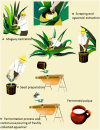Pulque, a Traditional Mexican Alcoholic Fermented Beverage: Historical, Microbiological, and Technical Aspects
- PMID: 27446061
- PMCID: PMC4928461
- DOI: 10.3389/fmicb.2016.01026
Pulque, a Traditional Mexican Alcoholic Fermented Beverage: Historical, Microbiological, and Technical Aspects
Abstract
Pulque is a traditional Mexican alcoholic beverage produced from the fermentation of the fresh sap known as aguamiel (mead) extracted from several species of Agave (maguey) plants that grow in the Central Mexico plateau. Currently, pulque is produced, sold and consumed in popular districts of Mexico City and rural areas. The fermented product is a milky white, viscous, and slightly acidic liquid beverage with an alcohol content between 4 and 7° GL and history of consumption that dates back to pre-Hispanic times. In this contribution, we review the traditional pulque production process, including the microbiota involved in the biochemical changes that take place during aguamiel fermentation. We discuss the historical relevance and the benefits of pulque consumption, its chemical and nutritional properties, including the health benefits associated with diverse lactic acid bacteria with probiotic potential isolated from the beverage. Finally, we describe the actual status of pulque production as well as the social, scientific and technological challenges faced to preserve and improve the production of this ancestral beverage and Mexican cultural heritage.
Keywords: Saccharomyces cerevisiae; aguamiel; dextran; fructans; lactic acid bacteria; maguey; probiotics; pulque.
Figures




References
-
- Alfaro Rojas G., Legaria Solano J. P., Rodríguez Pérez J. E. (2007). Diversidad genética en poblaciones de agaves pulqueros (Agave spp.) del noroeste del Estado de México. Rev. Fitotec. Mex. 30, 1–12.
-
- Anawalt P. R. (1998). Los conejos y la embriaguez. Arqueol. Mex. 9, 66–73.
-
- Argote-Espinosa R. M., Flores-Huerta S., Hernández-Montes H., Villalpando-Hernández S. (1992). Plasma clearance of ethanol and its excretion in the milk of rural women who consume pulque. Rev. Investig. Clínica Organo Hosp. Enfermedades Nutr. 44, 31–36. - PubMed
-
- Backstrand J. R., Allen L. H., Black A. K., de Mata M., Pelto G. H. (2002). Diet and iron status of nonpregnant women in rural Central Mexico. Am. J. Clin. Nutr. 76, 156–164. - PubMed
Publication types
LinkOut - more resources
Full Text Sources
Other Literature Sources
Miscellaneous

